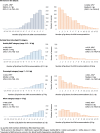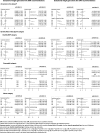Gestational weight gain outside the Institute of Medicine recommendations and adverse pregnancy outcomes: analysis using individual participant data from randomised trials
- PMID: 31477075
- PMCID: PMC6719382
- DOI: 10.1186/s12884-019-2472-7
Gestational weight gain outside the Institute of Medicine recommendations and adverse pregnancy outcomes: analysis using individual participant data from randomised trials
Abstract
Background: High Body Mass Index (BMI) and gestational weight gain (GWG) affect an increasing number of pregnancies. The Institute of Medicine (IOM) has issued recommendations on the optimal GWG for women according to their pre-pregnancy BMI (healthy, overweight or obese). It has been shown that pregnant women rarely met the recommendations; however, it is unclear by how much. Previous studies also adjusted the analyses for various women's characteristics making their comparison challenging.
Methods: We analysed individual participant data (IPD) of healthy women with a singleton pregnancy and a BMI of 18.5 kg/m2 or more from the control arms of 36 randomised trials (16 countries). Adjusted odds ratios (aOR) and 95% confidence intervals (CI) were used to describe the association between GWG outside (above or below) the IOM recommendations (2009) and risks of caesarean section, preterm birth, and large or small for gestational age (LGA or SGA) infants. The association was examined overall, within the BMI categories and by quartile of GWG departure from the IOM recommendations. We obtained aOR using mixed-effects logistic regression, accounting for the within-study clustering and a priori identified characteristics.
Results: Out of 4429 women (from 33 trials) meeting the inclusion criteria, two thirds gained weight outside the IOM recommendations (1646 above; 1291 below). The median GWG outside the IOM recommendations was 3.1 kg above and 2.7 kg below. In comparison to GWG within the IOM recommendations, GWG above was associated with increased odds of caesarean section (aOR 1.50; 95%CI 1.25, 1.80), LGA (2.00; 1.58, 2.54), and reduced odds of SGA (0.66; 0.50, 0.87); no significant effect on preterm birth was detected. The relationship between GWG below the IOM recommendation and caesarean section or LGA was inconclusive; however, the odds of preterm birth (1.94; 1.31, 2.28) and SGA (1.52; 1.18, 1.96) were increased.
Conclusions: Consistently with previous findings, adherence to the IOM recommendations seem to help achieve better pregnancy outcomes. Nevertheless, even in the context of clinical trials, women find it difficult to adhere to them. Further research should focus on identifying ways of achieving a healthier GWG as defined by the IOM recommendations.
Keywords: Body mass index; Gestational weight gain; Individual participant data; Institute of Medicine.
Conflict of interest statement
FGS is a member of the editorial board (Associate Editor) of BMC Pregnancy and Childbirth. The remaining authors declare that they have no competing interests.
Figures
Similar articles
-
Association between gestational weight gain in women with gestational diabetes mellitus and adverse pregnancy outcomes: a retrospective cohort study.BMC Pregnancy Childbirth. 2021 Jul 14;21(1):508. doi: 10.1186/s12884-021-03982-4. BMC Pregnancy Childbirth. 2021. PMID: 34261430 Free PMC article.
-
Outcomes of gestational weight gain outside the Institute of Medicine Guidelines.J Med Assoc Thai. 2014 Nov;97(11):1119-25. J Med Assoc Thai. 2014. PMID: 25675675
-
Association between gestational weight gain and pregnancy outcomes in a Singaporean population: A prospective cohort study.Eur J Obstet Gynecol Reprod Biol. 2022 May;272:160-165. doi: 10.1016/j.ejogrb.2022.03.031. Epub 2022 Mar 17. Eur J Obstet Gynecol Reprod Biol. 2022. PMID: 35325689
-
Association between prepregnancy body mass index or gestational weight gain and adverse pregnancy outcomes among Chinese women with gestational diabetes mellitus: a systematic review and meta-analysis.BMJ Open. 2024 Feb 17;14(2):e075226. doi: 10.1136/bmjopen-2023-075226. BMJ Open. 2024. PMID: 38367974 Free PMC article.
-
Association between gestational weight gain and perinatal outcomes among twin gestations based on the 2009 Institute of Medicine (IOM) guidelines: a systematic review.J Matern Fetal Neonatal Med. 2022 Dec;35(25):6527-6541. doi: 10.1080/14767058.2021.1918083. Epub 2021 May 27. J Matern Fetal Neonatal Med. 2022. PMID: 34044741
Cited by
-
The Association of Avoidance Coping with Gestational Weight Gain among Pregnant Black Women.West J Nurs Res. 2023 Mar;45(3):226-233. doi: 10.1177/01939459221127800. Epub 2022 Oct 4. West J Nurs Res. 2023. PMID: 36196018 Free PMC article.
-
Association of Pregestational BMI and Gestational Weight Gain with Maternal and Neonatal Outcomes in Adolescents and Adults from Mexico City.Int J Environ Res Public Health. 2021 Dec 28;19(1):280. doi: 10.3390/ijerph19010280. Int J Environ Res Public Health. 2021. PMID: 35010540 Free PMC article.
-
Association among pre-pregnancy body mass index, gestational weight gain and neonatal birth weight: a prospective cohort study in China.BMC Pregnancy Childbirth. 2020 Nov 12;20(1):690. doi: 10.1186/s12884-020-03323-x. BMC Pregnancy Childbirth. 2020. PMID: 33183261 Free PMC article.
-
Pregnancy Outcomes in Pregnant Women with HIV on Tenofovir Disoproxil Fumarate (TDF) Compared to Tenofovir Alafenamide (TAF).J AIDS HIV Treat. 2022;4(1):6-13. J AIDS HIV Treat. 2022. PMID: 35466327 Free PMC article.
-
The combined effect of pre-pregnancy body mass index and gestational weight gain on the risk of pre-labour and intrapartum caesarean section-The ICE-MCH study.PLoS One. 2023 Jan 5;18(1):e0280060. doi: 10.1371/journal.pone.0280060. eCollection 2023. PLoS One. 2023. PMID: 36603021 Free PMC article.
References
-
- Institute of Medicine . Weight gain during pregnancy - reexamining the guidelines. In: Rasmussen KM, Yaktine AL, editors. Technical Guidelines. Washington (DC): Institute of Medicine and National Research Council, The National Academies Press; 2009. - PubMed
Publication types
MeSH terms
Grants and funding
LinkOut - more resources
Full Text Sources
Medical
Miscellaneous



